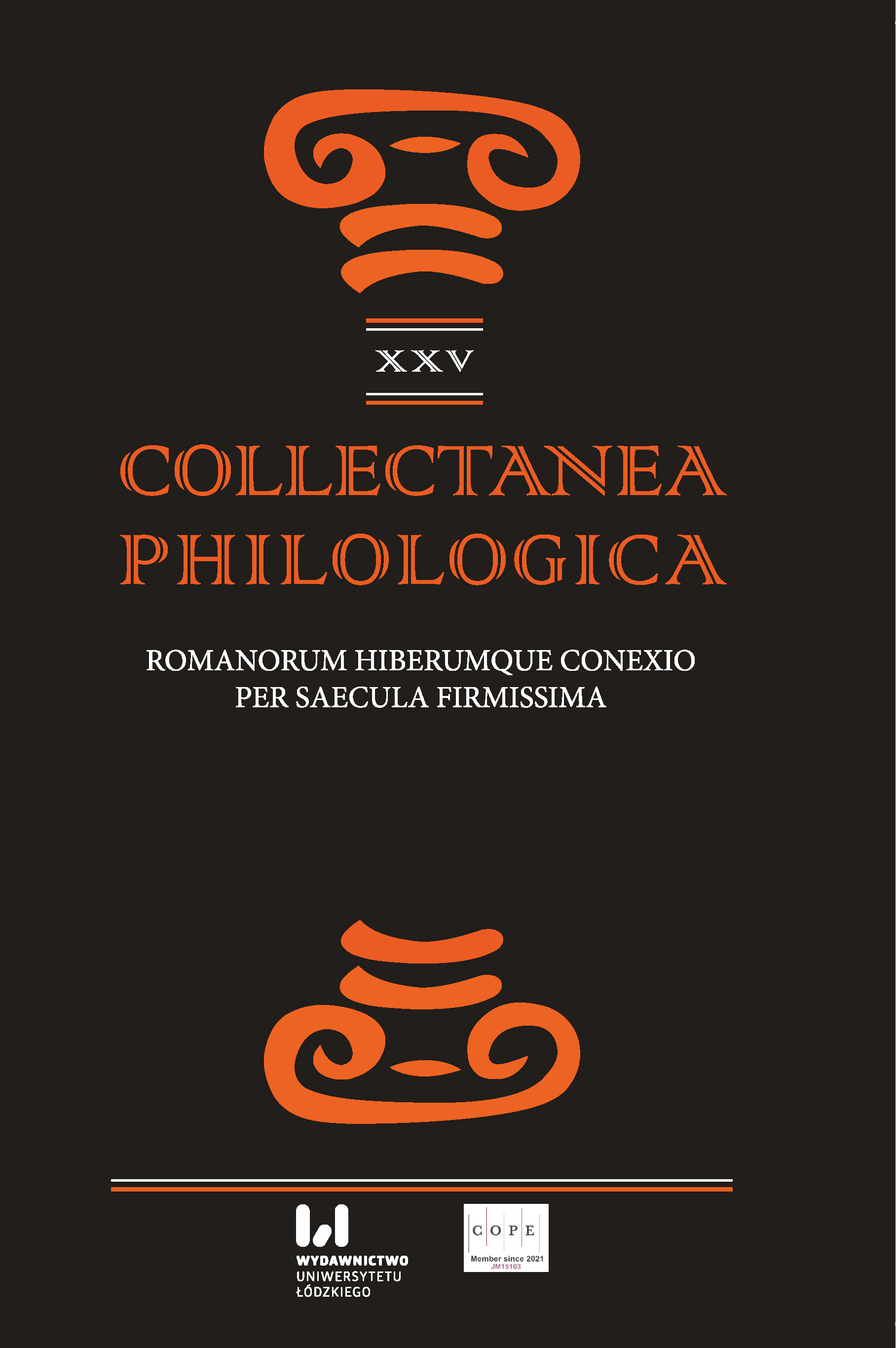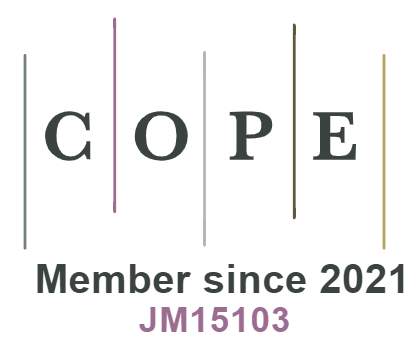Becoming Roman? Two-Sided Stelae in Lucus Augusti and its Hinterland
DOI:
https://doi.org/10.18778/1733-0319.25.15Słowa kluczowe:
rzymskie zabytki pogrzebowe, dwustronne stele, Lucus Augusti, tożsamość, togatusAbstrakt
In this article we analyze the two-sided stelae of Lucus Augusti and its hinterland, unique pieces throughout the Roman Empire, with the aim of compiling the information we have about them and analyzing them from the perspective of postcolonial romanization theories. To this end, Bourdieuʼs theory of habitus is fundamentally used, understanding habitus as a generator of principles of social behavior. The use of the toga in the representations of these stelae and their link with Roman citizenship are key to understanding who commissioned these funerary monuments, as well as the correct interpretation of the themes on the reverse provide us with new data. The analysis of the granite blocks allows us to know that they were not large stelae or with an epigraphic text that is now lost, but that it was a conscious choice which they did not have text rather images on both sides. The two-sided stelae are the reflection of a local custom, that is, part of a new hybrid culture: the provincial Galician-Roman culture.
*This article was supported by a PhD fellowship from the Spanish Ministry of Universities called “Ayudas para la Formación de Profesorado Universitario” (FPU19/00148). This research was conducted within the framework of the R+D+i project “Nuevas bases documentales para el estudio histórico de la Hispania romana de época republicana: ciudadanía romana y latinidad (90 a.C. – 45 a.C.)” (PID2019-105940GB-I00) (4 years).
Bibliografia
Abásolo Álvarez, J.A. (1977). “La estela discoide de Bezares (Valle de Valdelaguna, Burgos)”. Sautuola 2. 281–285.
Google Scholar
Abásolo Álvarez, J.A. (2008). El primer horizonte de escultura celtíbero-romana en la Meseta: las estelas de guerrero. In: J.M. Noguera Celdrán, M.E. Conde Guerri. Escultura romana en Hispania V. Murcia: Tabularium. 223–233.
Google Scholar
Acuña Castroviejo, F. (1974). “Notas sobre la morfología y la decoración en las aras y estelas de Galicia en la época romana”. Studia Archaeologica 32. 17–31.
Google Scholar
Acuña Castroviejo, F.; Casal García, R. (2011). A plástica provincial romana en Galicia: notas introdutorias a una exposición. In: X.R. Cuba Rodríguez (ed.). A plástica provincial romana no Museo de Lugo. Lugo: Servizo de Publicacións da Deputación de Lugo. 9–21.
Google Scholar
Alcorta Irastorza, E. (2011a). Estela bifronte da loba capitolina. In: X.R. Cuba Rodríguez (ed.). A plástica provincial romana no Museo de Lugo. Lugo: Servizo de Publicacións da Deputación Provincial. 30–31.
Google Scholar
Alcorta Irastorza, E. (2011b). Estela bifronte de Hércules. In: X.R. Cuba Rodríguez (ed.). A plástica provincial romana no Museo de Lugo. Lugo: Servizo de Publicacións da Deputación Provincial. 28–29.
Google Scholar
Alcorta Irastorza, E.; Rodríguez Colmenero, A. (1997). “De nuevo la Muralla de Lugo cantera de monumentos funerarios”. Lorouco 3. 228–230.
Google Scholar
Alcorta Irastorza, E.; Carnero Vázquez, M.O. (2010). Arqueoloxía (1990–2005). Lugo: M.P.L., Servicio de Publicaciones, Deputación de Lugo.
Google Scholar
Alonso Romero, F. (1981). “La nave romana de la estela de Vila de Sarria (Lugo)”. Brigantium 2. 1051–16.
Google Scholar
Alonso Romero, F. (2014). “La embarcación de la jarra romana del río Ulla (Galicia)”. Armario Brigantino 37. 93–102.
Google Scholar
Arias Vilas, F. (1991). La Conquista e integración del Noroeste en el Imperio Romano. In: J.M. García Iglesias (ed.). Galicia no tempo. Santiago de Compostela: Arcebispado de Santiago. 93–159.
Google Scholar
Balil, A. (1978). “Esculturas da época romana en Galicia. Aspectos y problemas”. Revista de Guimarães 88. 147–157.
Google Scholar
Balseiro García, A.; Carnero Vázquez, M.O. (2011). Muestras escultóricas del arte provincial romano en el Museo Provincial de Lugo. In: T. Nogales, I. Rodà (eds.). Roma y las provincias: modelo y difusión (Vol. II). Roma: L’Erma di Bretschneider. 763–770.
Google Scholar
Bendala Galán, M. (1995). Necrópolis y ritual funerario en la Hispania altoimperial. In: R. Fábregas Valcarce et al. (eds.). Arqueoloxía da Morte na Península Ibérica desde as Orixes ata o Medievo. Xinzo de Limia: Excmo. Concello de Xinzo de Limia. 277–290.
Google Scholar
Benoit, F. (1954). L’héroïsation équestre. Aix-en-Provence: Annales de la Faculté des Lettres.
Google Scholar
Bianchi, L. (1976). “Ancora sulla lupa di Apulum: aspeti del provincialismo dacico (Tavv. LVIII–LXIII)”. Archeologia Classica 28. 161–178.
Google Scholar
Blázquez, J.M. (1963). L’héroïsation équestre dans la Péninsule Ibérique. In : Celticum 6. Actes du Troisième Colloque International d’Études Gauloises, Celtiques et Protoceltiques. Rennes. 405–423.
Google Scholar
Blázquez, J.M. (2003). Arte provincial en la Gallaecia romana. In: P. Defosse (ed.). Hommages à Carl Deroux. Vol. IV. Archéologie et Histoire de lʼArt, Religion. Coll. Latomus 277. Bruselas: Latomus, 3–13.
Google Scholar
Bourdieu, P. (1977). Outline of a theory of practice. Trans. R. Nice. Cambridge: Cambridge University Press. https://doi.org/10.1017/CBO9780511812507
Google Scholar
DOI: https://doi.org/10.1017/CBO9780511812507
Bourdieu, P. (1990). The logic of practice. Trans. R. Nice. Standford: Standford University Press. https://doi.org/10.1515/9781503621749
Google Scholar
DOI: https://doi.org/10.1515/9781503621749
Bourdieu, P. (1997). Razones prácticas. Trans. T. Kauf. Barcelona: Anagrama.
Google Scholar
Carnero Vázquez, M.O. (2011a). Estela bifronte de Adai. In: X.R. Cuba Rodríguez (ed.). A plástica provincial romana no Museo de Lugo. Lugo: Servizo de Publicacións da Deputación Provincial. 24–25.
Google Scholar
Carnero Vázquez, M.O. (2011b). Estela bifronte de Atán. In: X.R. Cuba Rodríguez (ed.). A plástica provincial romana no Museo de Lugo. Lugo: Servizo de Publicacións da Deputación Provincial. 26–27.
Google Scholar
Cebrián Fernández, R. (2000). Titulum fecit. La producción epigráfica romana en las tierras valencianas. Madrid: Real Academia de la Historia.
Google Scholar
Crespo Pérez, C. (2018). “Las leyes suntuarias y la regularización el lujo en el Derecho Romano”. CSDDM. Diseño de Moda 4. 81–98.
Google Scholar
Díez Platas, F. (2005). “Sólo imágenes para la muerte: la cuestión de las estelas bifrontes galaicorromanas”. Semata 17. 61–74.
Google Scholar
Foucault, P. (1978). Microfísica del poder. Trans. J. Varela, F. Álvarez-Uría Rico. Madrid: Las Ediciones de la Piqueta.
Google Scholar
García Quintela, M.V. (1997). “Las puertas del Infierno y el Río del Olvido. (Un tema mítico céltico en la etnografía ibérica de Estrabón)”. Gallaecia 16. 145–157.
Google Scholar
González García, F. (2010). “Hábito epigráfico, decoración plástica e interacción cultural en el Noroeste hispano en época romana. Análisis de las estelas funerarias de Vigo (Pontevedra)”. Madrider Mitteilungen 51. 397–419.
Google Scholar
González Ruibal, A. (2006–2007). “Galaicos. Poder y comunidad en el Noroeste de la Península Ibérica (1200 a.C.–50 d.C.)”. Brigantium 18–19. A Coruña: Museo Arqueolóxico e Histórico.
Google Scholar
Hingley, R. (1996). The ‘legacy’ of Rome: The Rise, Decline, and Fall of the Theory of Romanization. In: J. Webster, N. Cooper (eds.). Roman Imperialism: Post-Colonial Perspectives. Leicester Archaeology Monographs 3. School of Archaeological Studies. University of Leicester. 34–48.
Google Scholar
Hingley, R. (2008). “Not so Romanized? Tradition, Reinvention or Discovery in the Study of Roman Britain.” World Archaeology 40(3). 427–443. https://doi.org/10.1080/00438240802261531
Google Scholar
DOI: https://doi.org/10.1080/00438240802261531
Hingley, R. (2011). “Globalization and the Roman empire: the genealogy of ‘Empire’”. Semata 23. 99–113.
Google Scholar
Jiménez Díez, A. (2008). Imagines Hibridae: Una aproximación postcolonialista al estudio de las necrópolis de la Bética. Madrid: Consejo Superior de Investigaciones Científicas, Instituto de Historia, Departamento de Historia Antigua y Arqueología.
Google Scholar
Le Roux, P. (1990), “Le phare, lʼarchitecte et le soldat: lʼinscription rupestre de la Corogne (CIL II, 2559)”. Miscellanea Greca e romana XV. 133–145.
Google Scholar
Mangas Manjarrés, J. (2015). “La religión de la Hispania romana”. De Medio Aevo 8(2). 1–24.
Google Scholar
Marco Simón, F. (1978). “Las estelas decoradas de los conventos caesaraugustano y cluniense”. Caesaraugusta 43–44. 3–259.
Google Scholar
Rivas Fernández, J.C. (1994). “La estela romana del togado de Arrabaldo (Ourense)”. Boletín Auriense 24. 95–112.
Google Scholar
Rodríguez Colmenero, A. (1997–1998). “Sobre dos nuevas estelas monumentales de Lucus Augusti”. Boletín do Museo Provincial de Lugo 8(1). 79–90.
Google Scholar
Rothe, U. (2020). The Toga and the Roman identity. London, New York: Bloomsbury Academic. https://doi.org/10.5040/9781474204477
Google Scholar
DOI: https://doi.org/10.5040/9781474204477
Saussure, F. de (1984). Curso de Lingüística General. Trans. M. Armiño. Barcelona: Akal.
Google Scholar
Simón Cornago, Ignacio (2017). “Los jinetes de las estelas de Clunia”. Acta Paleohispánica XII, Paleohispania 17. 383–406.
Google Scholar
Tellenbach (2014–2015). “Sobre vestimenta e identidad en el Imperio romano”. Saitibi. Revista de la Facultat de Geografía i Història 64–65. 37–51. https://doi.org/10.7203/saitabi.64.7271
Google Scholar
DOI: https://doi.org/10.7203/saitabi.64.7271
Tranoy, A. (1981). La Galice Romaine. Recherches sur le nord-ouest de la péninsule ibérique dans l’ Antiquité. París: De Boccard.
Google Scholar
Venturini, Carlo (2016). “Leges sumptuariae. Divieti senza sanzioni?”. Mélanges de lʼEcole française de Rome. Antiquité 128(1) (online). https://doi.org/10.4000/mefra.3141
Google Scholar
DOI: https://doi.org/10.4000/mefra.3141
Veyne, P. (1991). Humanistas: los romanos y los demás. In: A. Giardina (ed.). El hombre romano. Madrid: Alianza. 395–422.
Google Scholar
Wallace-Hadrill, A. (1989). “Review: Rome’s Cultural Revolution. Reviewed Works: The Power of Images in the Age of Augustus by Paul Zanker, Alan Shapiro; Augustus und die Macht der Bilder”. The Journal of Roman Studies 79. 157–164. https://doi.org/10.2307/301187
Google Scholar
DOI: https://doi.org/10.2307/301187
Wallace-Hadrill, A. (2008). Rome’s Cultural Revolution. Cambridge: Cambridge University Press.
Google Scholar
Wells, P.S. (1999). The Barbarians Speak. How the conquered peoples shaped Roman Europe. Princeton: Princeton University Press. https://doi.org/10.1515/9781400843466
Google Scholar
DOI: https://doi.org/10.1515/9781400843466
Woolf, G. (1997). “Beyond Romans and natives”. World Archaeology 28(3). 339–350. https://doi.org/10.1080/00438243.1997.9980352
Google Scholar
DOI: https://doi.org/10.1080/00438243.1997.9980352
Woolf, G. (1998). Becoming Roman. The origins of provincial civilization in Gaul. Cambridge: Cambridge University Press. https://doi.org/10.1017/CBO9780511518614
Google Scholar
DOI: https://doi.org/10.1017/CBO9780511518614
Zanker, P. (1992). Augusto y el poder de las imágenes. Trans. P. Diener Ojeda. Madrid: Alianza.
Google Scholar
Pobrania
Opublikowane
Jak cytować
Numer
Dział
Licencja

Utwór dostępny jest na licencji Creative Commons Uznanie autorstwa – Użycie niekomercyjne – Bez utworów zależnych 4.0 Międzynarodowe.
Funding data
-
Ministerio de Ciencia, Innovación y Universidades
Grant numbers PID2019-105940GB-I00 -
Agencia Estatal de Investigación
Grant numbers PID2019-105940GB-I00












